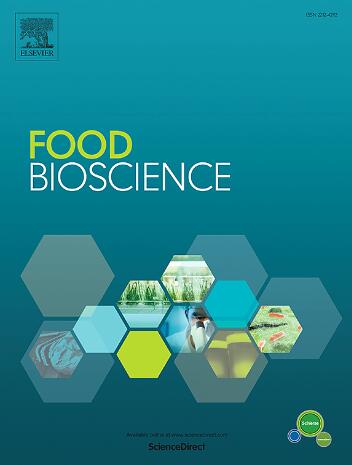针对α-淀粉酶和α-葡萄糖苷酶的天然抑制剂组合:一种更安全的2型糖尿病管理的食物来源策略
IF 4.8
1区 农林科学
Q1 FOOD SCIENCE & TECHNOLOGY
引用次数: 0
摘要
在2型糖尿病(T2DM)治疗中,迫切需要更安全的替代传统酶抑制剂(如阿卡波糖)的药物,这与新兴的自然疗法优于合成药物的治疗模式是一致的。本研究通过确定同时抑制α-淀粉酶和α-葡萄糖苷酶的协同组合,系统地评估了天然植物提取物的治疗潜力,α-淀粉酶和α-葡萄糖苷酶是碳水化合物消化的两个关键酶。通过对96种植物材料的初步筛选,获得了7种有前景的候选材料,本研究重点研究了表没食子儿茶素没食子酸酯(EGCG)与其他生物活性提取物的联合应用。体外酶抑制实验表明,EGCG与蛇葡萄提取物(EGCG - ag)联合使用对α-淀粉酶均有协同抑制作用(CI = 0.72;IC50 = 105.5μg / mL)和α葡糖苷酶(CI = 0.95;IC50 = 12.16 μg/mL),表明两种酶的协同抑制作用增强。荧光猝灭分析证实,EGCG-AG复合物对α-淀粉酶和α-葡萄糖苷酶的最大猝灭率分别为98%和99%。这些效应在发射峰上分别伴有17 nm和36 nm的特征性红移,表明酶活性位点在结合时发生了明显的构象重排。分子对接分析发现,AG的主要生物活性化合物二氢杨梅素与EGCG结合在靶酶上的不同位点,共同诱导构象变化,增强抑制作用。与传统的化学修饰策略相比,这种天然衍生的组合为开发功能食品、营养保健品和专门的膳食配方提供了更安全的途径。我们提出了一种有希望的食物来源干预策略,用于补充T2DM管理。本文章由计算机程序翻译,如有差异,请以英文原文为准。

Natural inhibitor combinations targeting α-amylase and α-Glucosidase: A food-derived strategy for safer type 2 diabetes management
The urgent need for safer alternatives to conventional enzyme inhibitors (e.g., acarbose) in type 2 diabetes mellitus (T2DM) management is consistent with the emerging paradigm favoring natural therapeutics over synthetic drugs. This study systematically evaluates the therapeutic potential of natural plant extracts by identifying synergistic combinations that concurrently inhibit α-amylase and α-glucosidase, two key enzymes in carbohydrate digestion. A preliminary screening of 96 plant materials yielded seven promising candidates, and this study focuses on the combination of epigallocatechin gallate (EGCG) with other bioactive extracts. In vitro enzyme inhibition assays demonstrated that the combination of EGCG and Ampelopsis grossedentata extract (EGCG–AG) exhibited synergistic effects against both α-amylase (CI = 0.72; IC50 = 105.5 μg/mL) and α-glucosidase (CI = 0.95; IC50 = 12.16 μg/mL), indicating enhanced cooperative inhibition of both enzymatic targets. Fluorescence quenching analysis confirmed that the EGCG–AG complex induced maximal quenching rates of 98 % and 99 % for α-amylase and α-glucosidase, respectively. These effects were accompanied by characteristic redshifts of 17 nm and 36 nm in the emission peaks, respectively, suggesting pronounced conformational rearrangements at the enzyme active sites upon binding. Molecular docking analysis identified that dihydromyricetin, the primary bioactive compound in AG, and EGCG bind to distinct sites on the target enzymes, cooperatively inducing conformational changes that enhance inhibition. Compared with conventional chemical modification strategies, this naturally derived combination offers a safer approach for the development of functional foods, nutraceuticals, and specialized dietary formulations. We present a promising food-derived intervention strategy for complementary T2DM management.
求助全文
通过发布文献求助,成功后即可免费获取论文全文。
去求助
来源期刊

Food Bioscience
Biochemistry, Genetics and Molecular Biology-Biochemistry
CiteScore
6.40
自引率
5.80%
发文量
671
审稿时长
27 days
期刊介绍:
Food Bioscience is a peer-reviewed journal that aims to provide a forum for recent developments in the field of bio-related food research. The journal focuses on both fundamental and applied research worldwide, with special attention to ethnic and cultural aspects of food bioresearch.
 求助内容:
求助内容: 应助结果提醒方式:
应助结果提醒方式:


